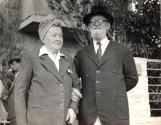27
Once in Jerusalem, the Arons contacted their old friend Rabbi Cohen. The Rabbi remembered his promise and found them an apartment at a low fixed rate. Paul Aron may have fulfilled a dream by moving to Jerusalem, but he had lost his business and the comfortable life that he had built in Frankfurt. The cost of leaving Germany had drained his financial resources. Paul Aron was forced to rely on his children to support him. In his final years, he also received some money as restitution from the German government.29
After the war, Paul Aron sent for the objects in his collection that had been left in Zurich. Before the war, these pieces had been prized for their ritual purposes and their aesthetic appearance. Now, they held even more value, as remnants of Jewish family life in Germany.One piece that is particularly significant in this regard is a small silver tower made to store the spices for the Havdalah ceremony. Havdalah marks the end of Shabbat and the return to secular life. During the ceremony, a blessing is recited over the spices and they are passed around to be smelled by everyone present. The pleasant aroma is intended to offer consolation over the departure of Shabbat.

